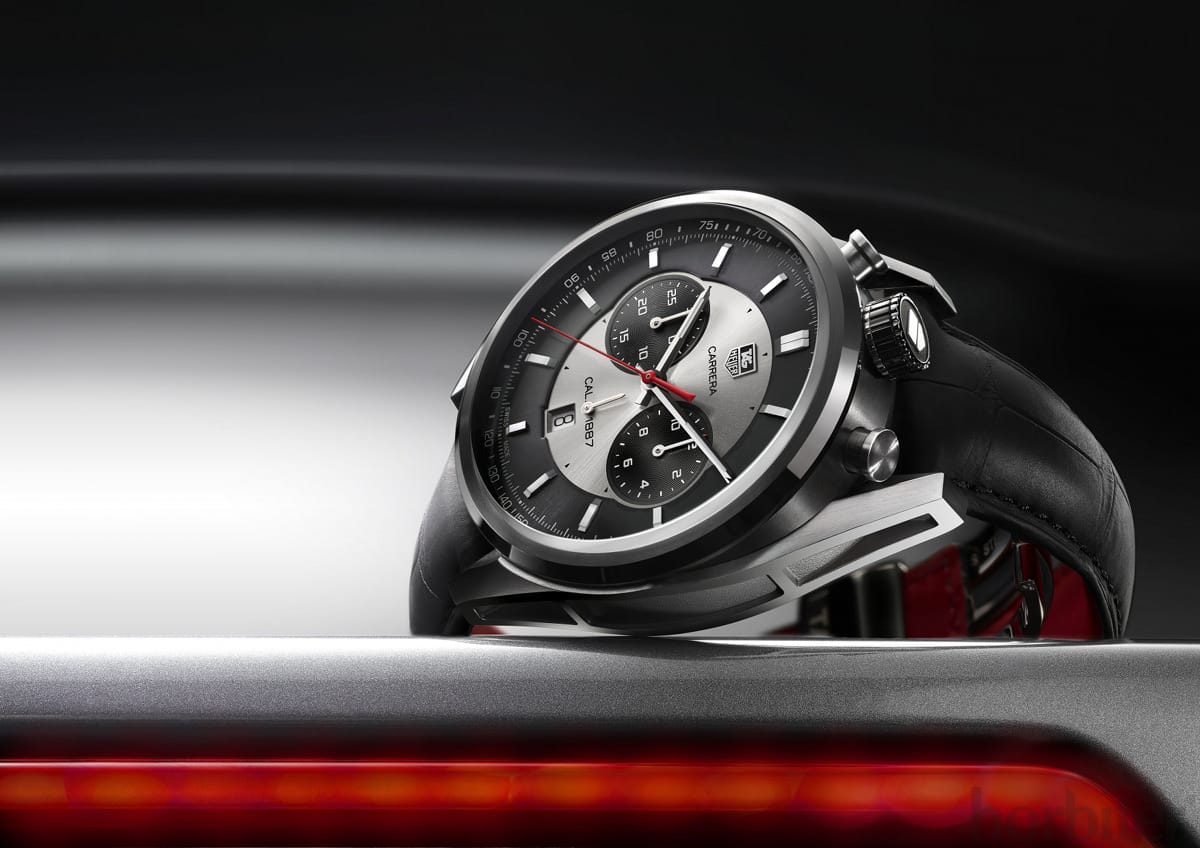Press Release: 50 years of CARRERA
CARRERA, FROM 1963 TO NOW:
ACCELERATED TECHNOLOGY AND DESIGN SAVOIR-FAIRE
TIMELESS MOTOR-RACING PRESTIGE
Speed, emotion, glamour: A half-century after its dramatic arrival on the motor-racing scene, the iconic CARRERA, the first sports chronograph designed specifically for professional drivers and sports-car enthusiasts, remains the standard-bearer of TAG Heuer’s unrivalled motorsports pedigree – a perfect synergy that began with Time of Trip (1911), the first car dashboard chronograph, and continues to this day through the brand’s ongoing partnerships with the best individuals and teams in driving disciplines around the world.
CARRERA: THE HISTORY
In 1963, Jack Heuer, the man responsible for some of the most groundbreaking advances in sports timekeeping, turned his attention to the specific needs of professional motor-racing drivers. A long-time fan of and participant in the sport, he knew exactly what was needed: a wide-open, easy-to-read dial and a shock-resistant and waterproof case tough enough for even the most intense road wear. He also had in mind the ideal inspiration: the “Carrera Panamericana Mexico Road Race”, the world’s most grueling open-road endurance competition. “I first heard about the Carrera from Pedro Rodriguez at the Twelve Hours of Sebring, where I was the Official Timekeeper. He and his brother Ricardo were two of the fastest, smartest and bravest endurance drivers of all time. To hear them talk of the Carrera, which our brand’s longtime friend Juan-Manuel Fangio had won in 1953, but which had been stopped in the 1955 after a number of fatalities, made my imagination soar. Just the sound of the name itself – elegant, dynamic, easily pronounced in all languages and charged with emotion. I knew then that my new chronograph was the perfect tribute to this legend.” He knew what the look and feel of the watch should be too. Inspiration came from a range of innovative ideas, including many from early 60s modernism – the geometric purity of Oscar Niemeyer’s new architecture, for example, and the curving, sensual lines of an Eero Saarinen building or chair, and the clean, uncluttered aesthetics of Pop-Art. At the same time, the Carrera’s iconic design values are firmly rooted in the enduring codes of motor sports, such as the black & white of vintage dashboard counters or the perforated leather gloves favored by Juan-Manuel Fangio and his contemporaries. “I was excited by the new forms, materials and techniques just then coming into play. We were after something that took advantage of these, that was just as new and audacious, but at the same time sober, simple and motorsports-driven, stripped of all ornamentation, classic and timeless.” Jack Heuer. The first Carrera chronograph was the stunning black and white “Panda” edition with tachymetre. An instant must-have watch of the top racecar drivers in Europe and America, it is now one of the most coveted watches among luxury watch collectors. Then, in 1969, the patented Carrera Chronomatic Calibre 11, the world’s first automatic chronograph was unveiled, changing the course of watch design. The name – a combination of the words “Chronograph” and “Automatic”, is among the most fabled in Swiss watchmaking history. Equipped with a 12-hour and a 30-minute counter, and the famous oscillating pinion invented by Edouard Heuer in 1887, the chronograph was outfitted with a special patented excentric regulator setting and moveable spiral block, which allowed for very precise regulation and the smallest error in the timing, even under the most extreme conditions. During the 1970s “Quartz crisis”, the Carrera not only survived, it excelled, with a series of popular quartz editions that demonstrated the brand’s continued preeminence as a pioneer in the Digital Age. Among the star pilots to wear a Carrera over the next decade were Ferrari drivers Jackie Ickx, Clay Regazzoni, Mario Andretti, Carlos Reutemann and Jody Scheckter. Every member of Ferrari’s 1970s 'scuderia', with whom Heuer had signed on as Official Sponsor and Timekeeper, received a solid gold Carrera engraved with his name and blood type. Since, It has been worn by every TAG Heuer driving greats: David Coulthard, Kimi Räikkönen, Fernando Alonso, Lewis Hamilton, Jenson Button, Alain Prost…
CARRERA: THE REBIRTH
In 1996, TAG Heuer relaunched the iconic line with the TAG Heuer Carerra Chronograph. The new flagship of the brand is one of the bestselling timepiece’s in the brand’s history. In 2004, two Automatics, the Carrera Tachymetre (41mm) and the steel-bracelet Carrera Watch, were added to the roster. In 2005, the Calibre 360 Concept Chronograph, the world’s first 1/100th of a second mechanical chronograph, was the talk of the BaselWorld watch fair. The following year, in a demonstration of TAG Heuer’s prowess at turning concepts into reality, the limited edition TAG Heuer Carrera Calibre 360 Rose Gold, was named “Sport’s Watch of the Year” at the Geneva Watchmaking Grand Prix. In 2010, the Carrera was the obvious choice for a new breakthrough: the Calibre 1887, a chronograph movement assembled in-house at TAG Heuer’s Swiss workshops. Winner of the 2010 Geneva Grand Prix’s prestigious “La Petite Aiguille” award, the movement pays tribute to the original Heuer oscillating pinion of 1887, one of the brand's first patents and a major benchmark in modern watchmaking. In 2011, TAG Heuer added two new standouts to the legacy: the Carrera Heritage, a full line of sporty, vintage-inspired Carreras, and the groundbreaking Carrera Mikrograph, the world’s first chronograph displaying the 1/100th of a second on a sweeping central hand. In 2012, the brand launched the TAG Heuer Carrera Mikrogirder, a dual-assortment, ultra high-frequency watch that beats 7.2 million times every hour and has a flying central chronograph hand that rotates 20 times per second. This astounding machine – the first timepiece ever created with neither a balance wheel nor a hairspring, is accurate to an unprecedented 5/10,000 of a second. At the Geneva Watchmaking Grand Prix ceremonies in November 2012, it was singled out as the best overall watch in all categories, taking home the prestigious Aiguille d’Or, the most coveted distinction in the global watch industry. Now, to mark the 50th year of the icon, TAG Heuer unveils its future.
CARRERA 2013: THE NEXT GENERATION
This year’s Carrera chronographs all house one of TAG Heuer’s proudest technical achievements – the in-house manufactured movement that re-engineers one of Edouard Heuer’s greatest contributions to watchmaking: the oscillating pinion of 1887.
THE CALIBRE 1887 MOVEMENT
The Calibre 1887 is an integrated column-wheel watch movement that vibrates 28,800 times per hour and has a 50-hour power reserve. Among it’s 320 components, is an audaciously re-engineered version of its inspiration, the brand’s 1887-patented oscillating pinion, along with a matching blue column wheel. The oscillating pinion, patented in 1887 by Edouard Heuer, works in tandem with the column wheel, in much the same way as an automobile transmission. The column wheel, which coordinates the start, stop and return-to-zero functions of the chronograph hand, functions like a gearbox. The oscillating pinion works like a clutch.
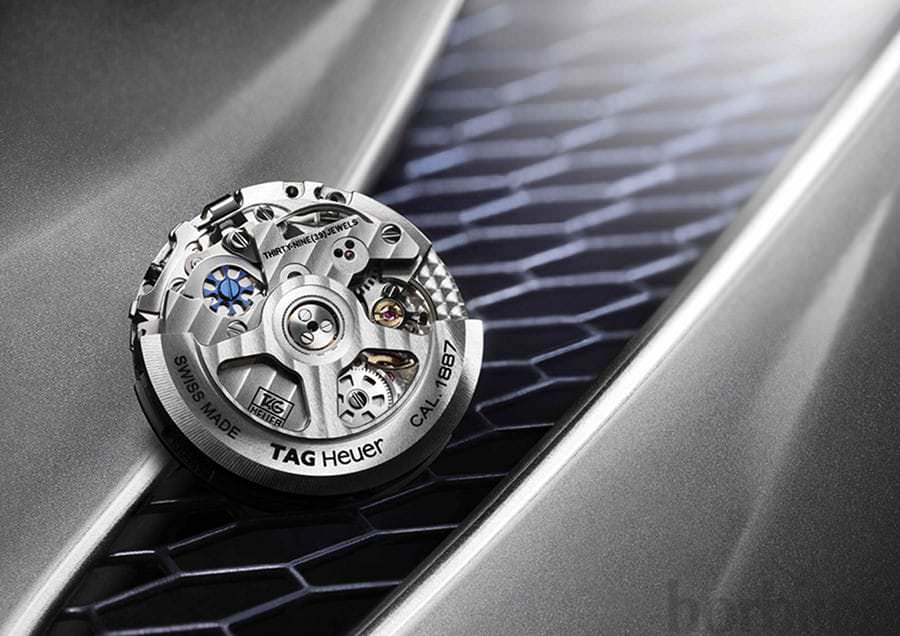
The 2013 CARRERA CALIBRE 1887 COLLECTION
CARRERA CALIBRE 1887 Jack Heuer Edition – 45mm – design based on the CARRERA Mikrogirder 10'000 winnner of the prestigious "Aiguille d'or " at Grand Prix d’Horlogerie de Genève.
TAG Heuer Honorary Chairman Jack Heuer, grandson of the brand’s founder and company CEO during its golden era of innovation in the 1960s and 1970s, is here celebrated in a spectacular edition inspired by the two-part construction Heuer stop watches that he once used on pro racing circuits around the world. The technical details, however, are all leading-edge, with elements borrowed from Vodafone McLaren Mercedes Formula 1 team and aeronautics: black titanium carbide steel bezel, hand-brushed and polished to a high sheen; polished, fine brushed and sandblasted steel and titanium cage; tachymetre and pulsometre on the dial. The innovative asymmetrical case design is based on the Carrera Mikrogirder – slightly rising at an angle at the top, where the crown and chronograph pushers are located. Jack Heuer’s coat of arms and signature decorate the smoked sapphire caseback, through which can be seen the audacious 39-jewel Calibre 1887 movement. In every way, a stunning tribute to the singular vision of a pioneer in technology and design.
CARRERA CALIBRE 1887 CHRONOGRAPH WITH CERAMIC BEZEL – 43MM
Based on the bestselling Calibre 16 design but outfitted with the the superlative Calibre 1887 movement and a host of other new technical elements – ceramic bezel with tachymetre scale, fine brushed and polished steel case and innovative H-shaped steel bracelet. The Arabic numerals – inspired by vintage counters–and the date window are hand applied. The viewing case back is in clear, unscratchable sapphire.A contemporary classic.
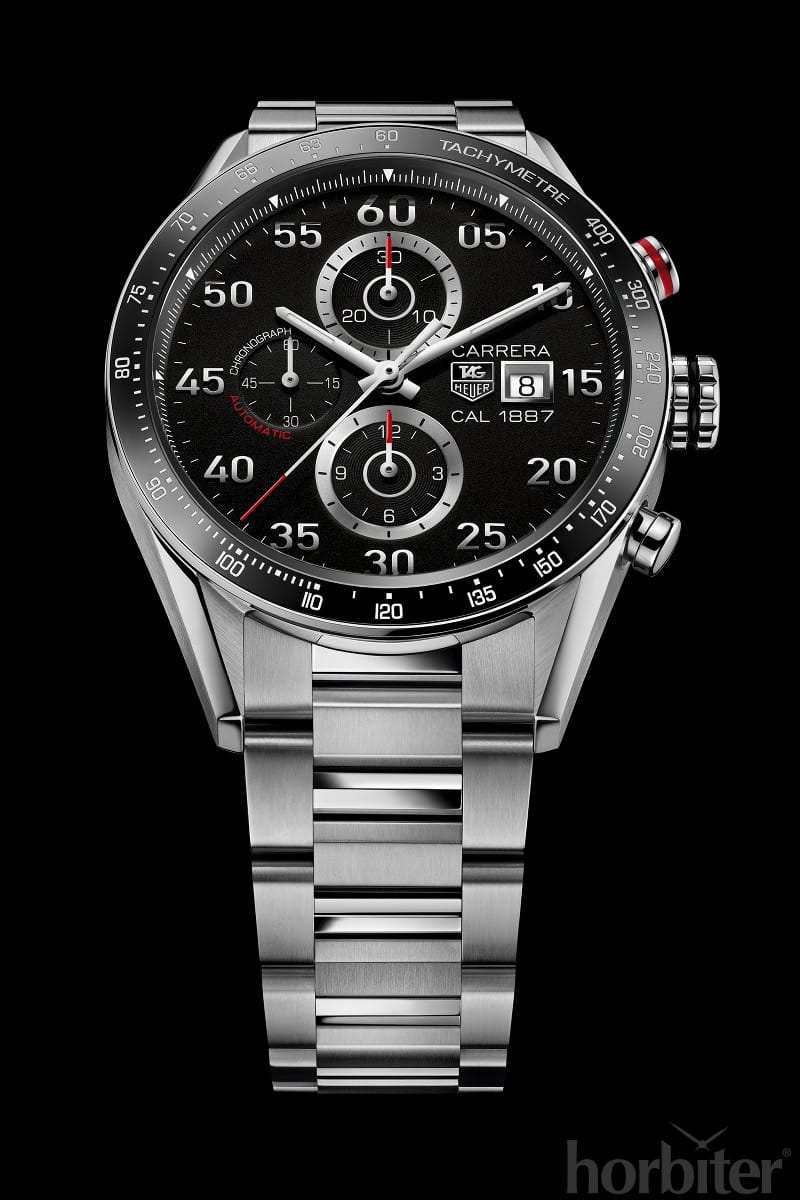
CARRERA CALIBRE 1887 RACING CHRONOGRAPH – 43MM
An authentic racing Carrera with serious design flair. New detailing include a sandblasted black titanium case, ceramic bezel with tachymetre scale, re-engineered black folding clasp for the high-tech “soft-touch” alligator strap. The caseback, now in smoked sapphire, offers full viewing of the impressive Calibre 1887. The counter-inspired numerals are in hand-applied black gold, as is the date window. A serious contender for pole position.
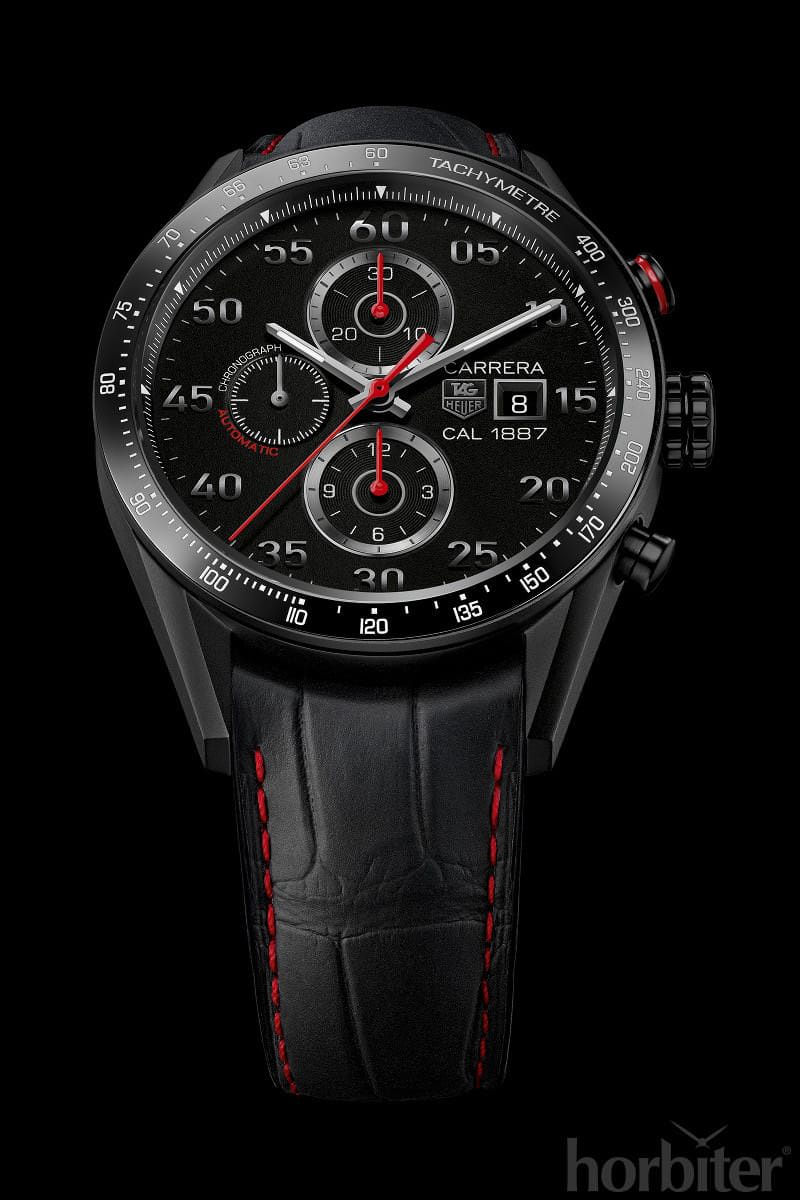
CARRERA CALIBRE 1887 CHRONOGRAPH – 41mm
A pure classic in the great Carrera tradition, with an uncluttered blue dial, discrete hour markers and elegant 41mm case size. Counters are at 12, 9 and 6. The chronograph pusher has superb operating feel and the overall look is very masculine and elegant, and very Carrera. With classic leather strap or new curved steel bracelet. The pacesetter.

CARRERA HERITAGE CALIBRE 1887 CHRONOGRAPH – 41mm
A new Calibre 1887 with the beloved “Heritage” dial on a standard-size case, replete with larger, very stylish and easy-to-read Arabic numerals, blued hands and a new curved steel bracelet or traditional blue leather strap. The result is a timeless luxury look, sober and refined. The reference bearer of a unique legacy.
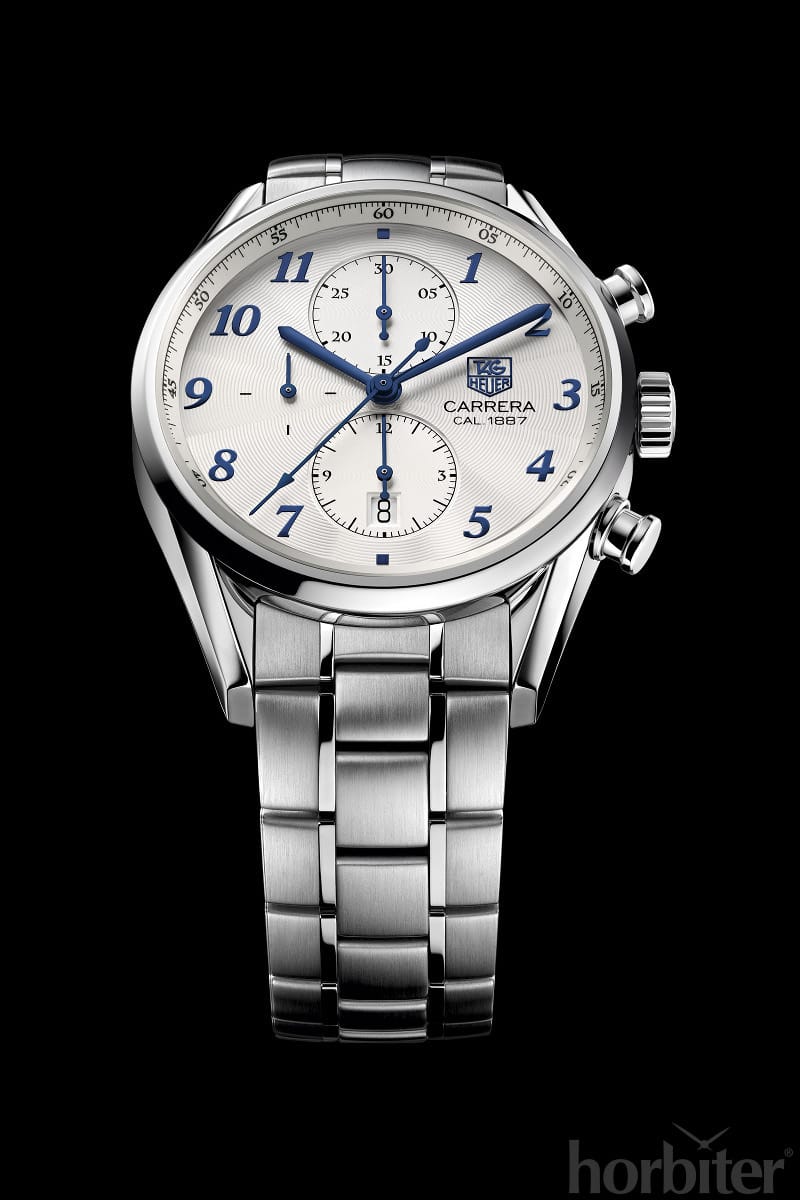
Gallery
(Photo credit: courtesy of TAG Heuer)
Gaetano C. @Horbiter – Watches & Luxury
